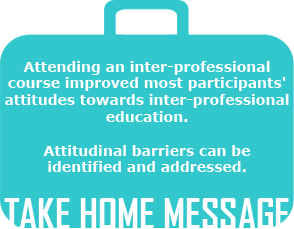



Theme
5JJ Interprofessional education 2
INSTITUTION
Great Ormond Street Hospital for Children
Postgraduate Medical Education Dept.
London, WC1N 3JH
Inter-professional education (IPE) is high on the UK healthcare education agenda. Despite this, recruiting participants and supporting their attendance at expensive and faculty-intense inter-professional courses (IPC) remains a challenge. Attitudinal factors are believed to significantly impact upon the success of IPE. To gain insight into these factors an educational evaluation was conducted at Great Ormond Street Hospital to explore participants’ attitudes towards IPE before and after attending our IPC on human factors called "Defining Moments...when things go wrong".

Click on 'more detail' for details of the Human Factors course
Thirteen course attendees, all senior healthcare professionals (doctors, nurses and a manager), completed a bespoke pre and post-course quantitative and qualitative questionnaire which was analysed using Qualtrics software.

Click on 'more detail' to see pre and post course questionnaires given to participants
Key Findings
- Self-selected group: Positive baseline attitudes towards IPE and IP courses across all three professional groups.
- Consistent improvement in attitudes, immediately post course.
- Statistically significant improvement in attitude towards IPCs being an “efficient use of resources” and “IPE should be an educational goal of this hospital”.
- Development of more personalized attitudes towards IPE post course.
- Advantages noted in first rather than third person
- Advantages related to their own workplace
- Identified risks to learning included
- Nurses: Fears about appearing less knowledgable, being passive members of the group, having their practise challenged
- Doctors: Fears about relevence of course content to them
- Concerns about relevance of the course to their professional group persisted for a minority
Click on 'more detail' for results tables and graphs
These findings help us continue to improve the impact of the “Defining Moments” course on inter-professional collaboration and patient care at our hospital.
Identifying barriers to attendance challenged us to
1. Include clearer descriptions of the course content made relevant to all professionals on our advertising
2. Make available pre-course materials to facilitate a shared knowledge base for all participants
3. Improve facilitator awareness of potential inter-professional dynamics during the course.

 Ethical approval for this study was granted by the Institute for Health Research (IHREC Reference 192) through the University of Bedfordshire and by the Ethics committee at Great Ormond Street Hospital.
Ethical approval for this study was granted by the Institute for Health Research (IHREC Reference 192) through the University of Bedfordshire and by the Ethics committee at Great Ormond Street Hospital.
 We would like to thank Ben Betts at HT2 (www.ht2.co.uk) for their expertise in developing the Human Factors serious game.
We would like to thank Ben Betts at HT2 (www.ht2.co.uk) for their expertise in developing the Human Factors serious game.
Lastly we would like to thank all the participants for their honesty and commitment to this study.
 Send Email
Send Email